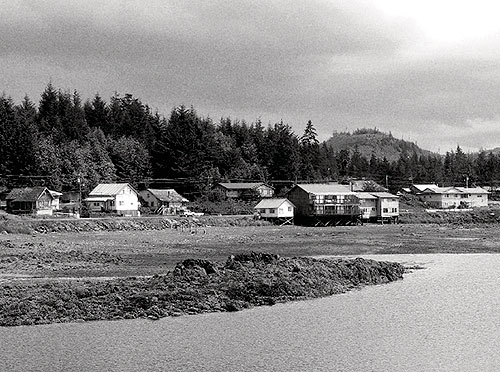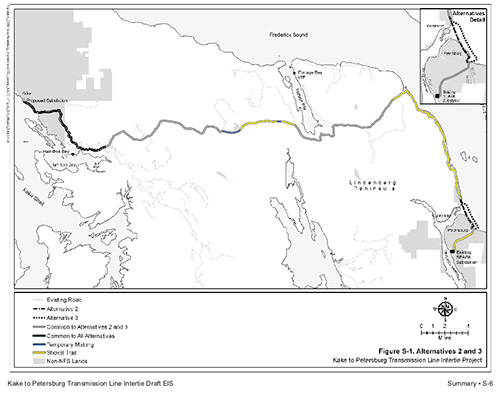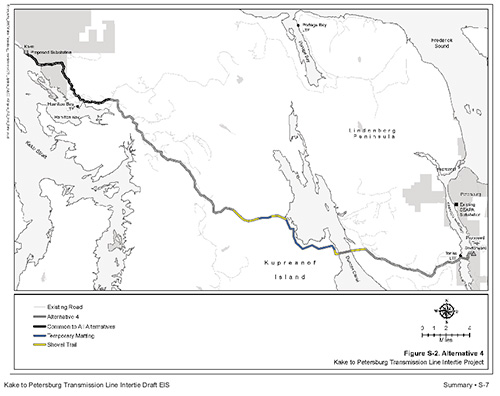
Milestone in the Kake-Petersburg Intertie Permitting Process
January 01, 2015
The Forest Service has issued a Draft Environmental Impact Statement for the project, and a 45-day comment period on the document began on December 26th. A final decision on the project is expected in July 2015.
Kake, Alaska At 62 cents per kilowatt hour (kWh), Kake currently pays one of the higher electrical rates in the nation. The community of Kake is presently served by an isolated electric system that depends upon high-cost, diesel generation. This isolated system is served by a diesel plant that consists of three diesel generators originally installed in 1984 (1 unit) and 1993 (2 units). High operation and maintenance expenses and high fuel costs make diesel generators costly to operate. In 2011, the full retail cost of power in Kake was 62 cents per kilowatt hour (kWh), more than five times the rate in the communities of Petersburg, Ketchikan, and Wrangell (Fay et al. 2012). The cost of electricity in Kake is currently subsidized for residential customers and public facilities through the State of Alaska’s Power Cost Equalization (PCE) program, which is funded on an annual basis by the State legislature. However, commercial use pays full rate. The proposed project would connect Kake to SEAPA’s interconnected network and provide access to relatively low cost electricity. SEAPA’s interconnected network includes the communities of Ketchikan, Wrangell, and Petersburg, the Swan Lake and Lake Tyee hydroelectric projects, and approximately 175 miles of transmission line that extend from Ketchikan to Petersburg. The Forest Service proposes to authorize the construction, operation, and maintenance of the proposed Kake and PetersburgIntertie Project across National Forest Service lands. A special use authorization would need to be issued to allow this use. Southeast Conference began focusing on a plan to implement a regional electrical intertie in earnest in 1997, and in 2002, the Kake-Petersburg intertie segment was prioritized by the Conference and its membership due to Kake’s close proximity to Petersburg, and the fact that Kake is 100% dependent on diesel-generated electricity. Businesses in Kake pay five to six times the amount for electricity that customers in Petersburg do. The power line between the communities would be between 52 and 60 miles long, depending on the route. Shelly Wright, Executive Director of Southeast Conference credits Kake mayor Henrich Kadake with getting the project to this stage. “This project could bring such value to the residents of Kake and we are hopeful it will be completed. Without the perseverance and determination of Mayor Kadake this would not have happened.” Mayor Kadake had this to say about the project. “I’ve been working on this project for at least 15 years, but I never gave up on it. In the last 10 to 12 years, we have really pushed hard on this. We need lower cost energy in Kake. Affordable energy would make a big difference in this community. It would mean that people could create their own businesses. It would really help places like our cold storage that only operates for three months out of the year. We want to be able to afford to run it year round. This review process is one of the last steps of getting everything permitted and shovel ready. Hopefully one day it will be funded and we can build it.” The project represents agreements between a number of players from across the region, including the communities of Petersburg and Kake, the Southeast Alaska Power Agency, the Inside Passage Electric Cooperative, the Alaska Energy Authority, as well as the significant efforts of Robert Venables, the Southeast Alaska Energy Coordinator for Southeast Conference. “Joint efforts such as this is what living in Southeast Alaska is all about and truly embodies the mission of Southeast Conference. It speaks to the importance of taking care of each other in the region and making sure everyone has something to hang on to,” noted Wright. Southeast Alaska’s hydropower resources are one of the region’s great strengths, because it is clean, “green,” inexpensive, and essentially unlimited in our rainforest climate. While the major population centers in Southeast Alaska have been well served by renewable hydroelectric power for more than a century in some cases, a few communities like Kake still rely on diesel generation to meet their energy needs. Lowering the cost of power in Kake will remove barriers to business development and expansion. Jodi Mitchell, CEO of the Inside Passage Electric Cooperative (IPEC), which currently provides Kake its energy says that she is happy to see that the permitting process for this project is finally nearing completion after so many years of effort. However, she also expressed frustration at the difficulty in permitting projects such as these. “At the beginning of this project, the estimated cost was $17 million. However, the project price has ballooned, and current estimates now exceed $60 million. So the next challenge is to find funds for the development stage of the project, which may be difficult considering current fiscal realities and the decreasing price of oil,” she noted. The Alaska Legislature provided funding for this project. The Inside Passage Electric Cooperative (IPEC) has worked tirelessly to find renewable energy solutions for Kake and was also awarded funding for the NEPA process and necessary EIS. Together with contractors, Tetra Tech, Commonwealth and D. Hittle & Associates, the intertie project moved from the conference room to actual fieldwork. With facilitation from the Alaska Energy Authority, a MOU was signed between IPEC and SEAPA that moved the intertie project to the next level that would outline the scenarios by which SEAPA could become the owner and operator of the intertie. The EIS and preliminary design work continued by SEAPA, its contractors and the USFS has finally concluded with the issuance of the draft EIS. The project area encompasses 493,806 acres on Mitkof and Kupreanof Islands, with the majority of the area located on Kupreanof Island. This total consists of 453,980 acres of National Forest System (NFS) lands, with the remaining lands (39,826 acres) owned and managed by the Alaska Department of Natural Resources (Alaska DNR), the Sealaska Corporation, Kake Tribal Corporation, the city of Kake, and Petersburg Borough. Alternatives being considered include: Alternative 1 – No Action Alternative 1 is the no action alternative and is analyzed to provide a baseline for evaluation of the impacts associated with the action alternatives. Under this alternative, the Forest Service would not provide authorization for the proposed project and a new electric transmission line would not bebuilt. The cit of Kake would continue to be served by th eexisting,isolated electric system, which depends upon high-cost diesel generation. Alternative 2 – Proposed Action Alternative 2 is 59.9 miles long. The majority of the transmission line (57.3 miles) would be above ground, with the remaining 2.6 miles located beneath Frederick Sound and the Wrangell Narrows (1.2 miles) and underground along Sandy Beach Road in Petersburg (1.4 miles). The average span length between structures would range from 350 to 400 feet and approximately 813 single-pole structures would be installed (Table S-1).
Figure S-1, Alternatives 2 and 3
Alternative 3 – Northern Route with Submarine Cable Alternative 3 starts at the existing SEAPA substation south of Petersburg. Staying south of Petersburg, the alternative follows an existing gravel road 3.5 miles east-northeast to Frederick Sound. The transmission line would cross Frederick Sound via a 3.1-mile-long submarine cable that would come ashore near Prolewy Point on the east shore of Kupreanof Island. This proposed crossing is the only difference between Alternatives 2 and 3. This crossing would originate near Sandy Beach Park. This alternative is 60.3 miles long. The majority of the transmission line (57.3 miles) would be above ground, with the remaining 3.1 miles located along the floor of Frederick Sound. The average span length between structures would range from 350 to 400 feet and approximately 813 single-pole structures would be installed (Table S-1). Alternative 3 would also include a 24-strand fiber optic communication cable. An estimated 61 percent or 35.2 miles of the overhead portion of the proposed transmission line would follow existing roads. A total of 7.6 miles of temporary access spurs would be required for this alternative. Access for construction along the remaining 22.1 miles (39 percent) of the overhead portion of the route would be via shovel trails supported by temporary matting panels in some wetland areas (Figure S-1).
Figure S-2, Alternative 4 Alternative 4 – Center-South Route Alternative 4 is 51.9 miles long. The majority of the transmission line (50.4 miles) would be above ground, with the remaining 1.5 miles located under Wrangell Narrows and Duncan Canal. The average span length between structures would range from 350 to 400 feet and approximately 748 single-pole structures would be installed (Table S-1). Alternative 4 would also include a 24- strand fiber optic communication cable. An estimated 74 percent or 37.3 miles of the overhead portion of the proposed transmission line would follow existing roads. A total of 6.2 miles of temporary access spurs would be required for this alternative. Access for construction along the remaining 13.1 miles (26 percent) of the overhead portion of the route would be via shovel trails supported by temporary matting panels in some wetland areas (Figure S-2). This alternative would connect to the existing Tyee-Wrangell-Petersburg transmission line approximately 8 miles south of Petersburg and would require a new tap or small switch yard at this location. The alternative would then cross the Wrangell Narrows and Duncan Canal via submarine cable crossings, approximately 0.6 mile and 0.9 mile in length, respectively. From the Wrangell Narrows crossing, the Center-South route corridor follows Forest Road 6350 across the Lindenberg Peninsula to Duncan Canal. Across Duncan Canal, the corridor continues across an unroaded area to Forest Road 6314S and from there parallels existing NFS roads to Kake (Figure S-2). A public hearing in Kake for the project will take place on January 13, 2015. A copy of the Draft EIS is available for review at the Petersburg Ranger District, other Tongass National Forest district offices, and the Forest Supervisor’s Office in Ketchikan. The document is also available for review online. To comment on the draft EIS, email the U.S. Forest Service with Kake-Petersburg Intertie in the subject line to Tom Parker at tparker02@fs.fed.us , or mail your written comment to Tom Parker at 12 North Nordic Drive, P.O. Box 1328, Petersburg, AK, 99833-1328 Comments are due by 02/11/2015.
Edited by Mary Kauffman, SitNews
On the Web:
Source of News:
|
||


